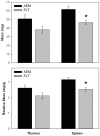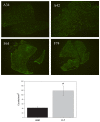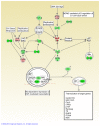Changes in mouse thymus and spleen after return from the STS-135 mission in space
- PMID: 24069384
- PMCID: PMC3777930
- DOI: 10.1371/journal.pone.0075097
Changes in mouse thymus and spleen after return from the STS-135 mission in space
Erratum in
-
Correction: Changes in Mouse Thymus and Spleen after Return from the STS-135 Mission in Space.PLoS One. 2013 Sep 27;8(9):10.1371/annotation/e66bdc4e-2409-4582-b163-7bc182db275e. doi: 10.1371/annotation/e66bdc4e-2409-4582-b163-7bc182db275e. eCollection 2013. PLoS One. 2013. PMID: 24116253 Free PMC article.
Abstract
Our previous results with flight (FLT) mice showed abnormalities in thymuses and spleens that have potential to compromise immune defense mechanisms. In this study, the organs were further evaluated in C57BL/6 mice after Space Shuttle Atlantis returned from a 13-day mission. Thymuses and spleens were harvested from FLT mice and ground controls housed in similar animal enclosure modules (AEM). Organ and body mass, DNA fragmentation and expression of genes related to T cells and cancer were determined. Although significance was not obtained for thymus mass, DNA fragmentation was greater in the FLT group (P<0.01). Spleen mass alone and relative to body mass was significantly decreased in FLT mice (P<0.05). In FLT thymuses, 6/84 T cell-related genes were affected versus the AEM control group (P<0.05; up: IL10, Il18bp, Il18r1, Spp1; down: Ccl7, IL6); 15/84 cancer-related genes had altered expression (P<0.05; up: Casp8, FGFR2, Figf, Hgf, IGF1, Itga4, Ncam1, Pdgfa, Pik3r1, Serpinb2, Sykb; down: Cdc25a, E2F1, Mmp9, Myc). In the spleen, 8/84 cancer-related genes were affected in FLT mice compared to AEM controls (P<0.05; up: Cdkn2a; down: Birc5, Casp8, Ctnnb1, Map2k1, Mdm2, NFkB1, Pdgfa). Pathway analysis (apoptosis signaling and checkpoint regulation) was used to map relationships among the cancer-related genes. The results showed that a relatively short mission in space had a significant impact on both organs. The findings also indicate that immune system aberrations due to stressors associated with space travel should be included when estimating risk for pathologies such as cancer and infection and in designing appropriate countermeasures. Although this was the historic last flight of NASA's Space Shuttle Program, exploration of space will undoubtedly continue.
Conflict of interest statement
Figures






References
-
- Chapes SK (2004) Lessons from Immune 1-3: what did we learn and what do we need to do in the future? J Gravit Physiol 11: 45-48. - PubMed
Publication types
MeSH terms
Substances
Grants and funding
LinkOut - more resources
Full Text Sources
Other Literature Sources
Research Materials
Miscellaneous

